At this year’s 2018 AIA National Convention and Expo there were a well-attended group of software and technology companies. In this Part 1 report, we go through the four larger BIM players there and what they were showing.
Reports From the Show Floor
Autodesk
Autodesk introduced BIM 360 Design at AIA and Angi Izzi, Global Industry Strategy & Business Manager, Autodesk, and her team was there to discuss that product in particular at length with me. This year we have noted how important CDE’s (common data environments) are to the AEC markets and Autodesk has done great work consolidating their array of solutions around their open API Forge Platform.
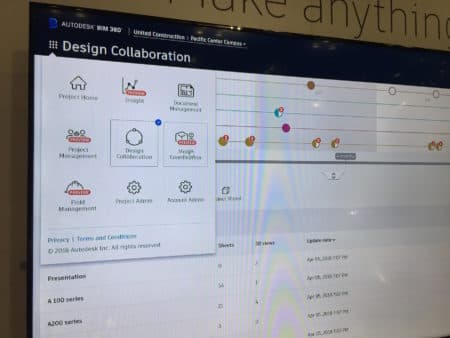
01 – Not the best image but BIM 360 nonetheless at the entry point level showing the various solution modules and the timeline with workflow packages show across the top (right).
Izzi noted that Autodesk refers to BIM 360 as a “common data platform”, but it is essentially a CDE. The Autodesk Forge API enables third-party developers to plug into BIM 360, including major competitors. On the construction side, the photo below (image 03) shows some of the Forge Construction Partner Ecosystem players, including companies like Egnyte, Assemble, and Pype.
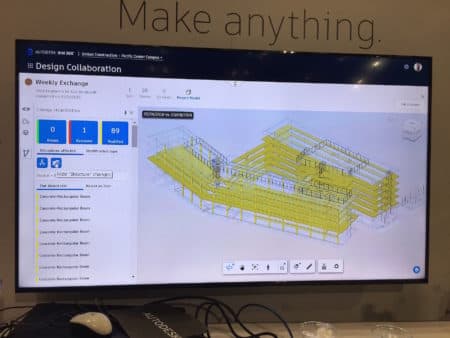
02 – BIM 360 Design has a clean uncluttered user-interface. In this view, we are looking at the state of the BIM model associated with a particular deliverable package. One can compare BIM model across states in time, with “green” elements being added, “yellow” changed, and “red” deleted to the model.
The latest release of Revit 2019 was also in the booth for architects to witness and review. The new version of one of the world’s most popular, if not the most popular, BIM authoring application, was released back in April focused on Design, Optimize and Connect themes. (see: Architosh, “Autodesk Releases Revit 2019—Multidisciplinary BIM Application,” 11 April 2018)
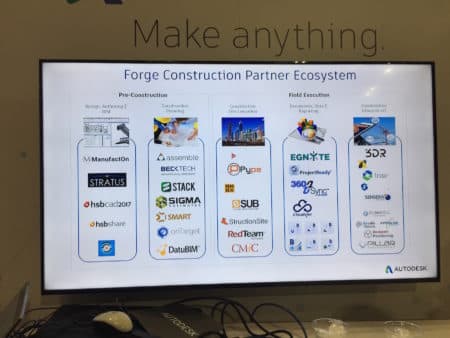
03 – A listing of some of the third-party Forge API based partners writing integrations into BIM 360.
Most of the major competing CDEs for the architecture industry now have open, published API’s (application programming interfaces) for third-party software integrations. This is a healthy list of construction-facing companies. Autodesk is particularly interested in “design to fabrication” which deals with the evolving nature of both the AEC industry building and product manufacturing.
Bentley
Bentley Systems was at AIA, though apart from the software pavilion area, and busy nonetheless. AECOsim is the company’s primary BIM authoring application aimed at the industry and Andy Smith, an architect with Bentley and Christine Byrne their longtime public relations and marketing lead ran through their key applications on display at the booth.
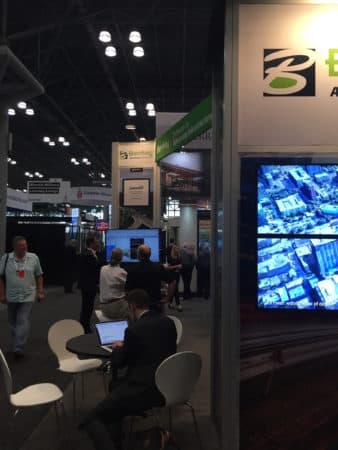
04 – Bentley’s booth at AIA is often, like this year, twice the size of the other major AEC software vendors, with everything from LumenRT, AECOsim and ContextCapture et al., on display in different sections of its booth.
Bentley was there to tout the benefits of its AECOsim—which we learned at the show exactly how to pronounce (it’s EEK-oh-sim). AECOsim is Bentley’s multi-disciplinary BIM application based on core Microstation technology, as Andy Smith explained to both Pete and me. It is important to note that this core technology includes the industry-leading Parasolid 3D modeling kernel and Smith touted AECOsim for its industry-leading modeling and visualization capabilities. Bentley has an i-models format which is a “container” for exchanging infrastructure information and for interaction with various model data, regardless of authoring application.

05 – Generative Components (often known as just GC) is inside AECOsim where architects and engineers can engage directly in algorithmic design.
To recap the issue of what a common data environment (CDE) can mean in the AEC industry, Andy Smith had another definition—”connected data environment.” He noted that what is important to emphasize is the “connectedness” between data and workflows and of course, between various Bentley software systems.
MORE: AIA2018: Bentley Announces Acquisition of Synchro Software
AECOsim in its latest form has a revamped user interface (quite clean!) with a task-based nodal control that changes the UI based on what you are aiming to do. Bentley’s Generative Components (GC) technology is built into AECOsim, (see image 05), for example, allowing architects to engage in algorithmic computational design directly in AECOsim.
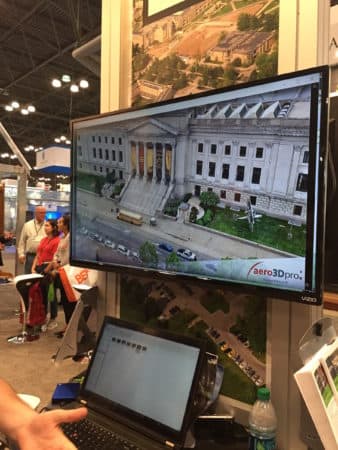
06 – ContextCapture is Bentley’s reality modeling technology brand enabling vast 3D models from photographic datasets.
Reality modeling is a major thrust in Bentley’s current arsenal, and the company is sitting on some impressive technology in this space. Branded as Bentley ContextCapture, users can take both photos and even video to feed into ContextCapture to produce highly detailed and realistic 3D models of any size to utilize in their design workflows. The software system—a capture to model workflow—ingests both photography and point-cloud data.
GRAPHISOFT
Known in the industry for having the original BIM application, ARCHICAD, the Hungarian software innovator had a very busy booth (as can be seen in the photos). For this company, its annual software release tends to time very well for AIA National. The company just announced ARCHICAD 22.
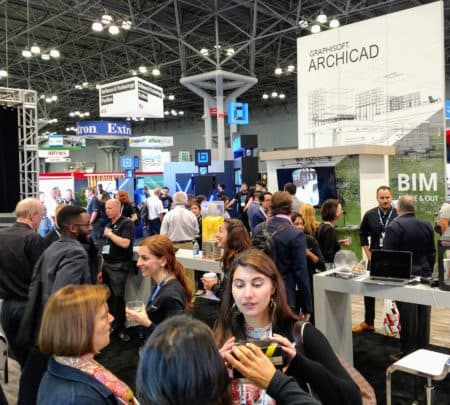
07 – The GRAPHISOFT booth was showcasing the latest release of ARCHICAD 22 with its new facade design tools, among other items. (image courtesy of Graphisoft / All rights reserved)
GRAPHISOFT’s BIM authoring application is intently focused on just one discipline—architecture. Unlike Autodesk and Bentley, this isn’t a multi-disciplinary BIM application. The company emphasizes interoperability via Open BIM for engagement with other disciplines. The newest version touts a revamped facade design tool with some impressive design control systems and integration with its increasingly deepening connection to the world of McNeel Associates’ Rhino and Grasshopper applications.

08 – The newly revised facade tool in AC 22 can be powered by Grasshopper, shown here how an image can be used as the source material for a pattern in the facade tool system. The facade tool can be used for screens applied to build facades inside and out, and ceiling surfaces as well. It is not just limited to glazing systems.
Within the new facade design tools, Eniko Pauko of GRAPHISOFT was showing Pete and I just how flexible the system actually is by utilizing a famous image of Steve Jobs with Grasshopper to algorithmically generate a screen pattern driven within the new facade design tool.
MORE: GRAPHISOFT Introduces ARCHICAD 22—Built for Facade Design Masters
The company was also showing BIMx which continues to evolve and improve on both leading mobile device operating systems. As we noted in this feature report here (see: Architosh, “INSIDER: GRAPHISOFT’s BIM World—From the banks of the Danube to Toyko,” 27 Dec 2017) BIMx aims to be an information access platform in its own right, via an API. This will be one of the most exciting new areas to watch as Nemetschek Group companies begin to converge data interoperability not strictly around file formats meant for such a purpose (ie: IFC) but around API-driven cloud-to-cloud and cloud-to-apps solutions.
Vectorworks Architect
Vectorworks, Inc., was the fourth major BIM authoring platform provider at AIA National. Their Vectorworks Architect 2018 software was released last year in the fall, but additional features have been added in a mid-release service pack.

10 – Vectorworks’ booth was adorned by a large display by PixelFLEX shown here in the middle. (image courtesy of Vectorworks, Inc. / All rights reserved).
The big new feature for Vectorworks Architect 2018 was the introduction of multiple viewports support common in high-end professional 3D software packages but not common among the leading BIM applications until this year. The latest release of Revit this year also introduced this capability, and Bentley’s AECOsim has it as well. Such a feature enables users to work on BIM models by viewing the 3D model from several different viewpoints or projections at once.
In the case of Vectorworks Architect 2018, the multiple viewports can be spread across multiple monitors as well, enabling up to 10 more different views on a BIM model. A key feature US architects may have asked folks at the Revit booth might of been how they can utilize the many Revit objects out in the market, particularly by product manufacturers. The answer would have been Vectorworks 2018’s new ability to create “native Vectorworks objects” from imported Revit files.
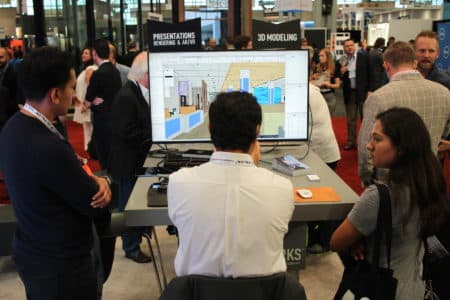
10 – Booth visitors gain insight into Vectorworks’ 3D capabilities, of which in this last release increased in significant ways with site modeling and subdivision surfaces (subDs) modeling.
Vectorworks Architect 2018 can generate rendered 360-degree panoramas viewable inside VR headgear, including Vive, Oculus Rift, and Google Daydream. Additionally, the same service pack that brought users high-end VR headset support also includes reality capture to 3D models support and recently new Bluebeam integration. Finally, the company’s booth was illuminated by a prominent display by Vectorworks partner PixelFLEX™ which makes award-winning LED video displays.
We will post more show floor reports soon.



Reader Comments
Comments for this story are closed